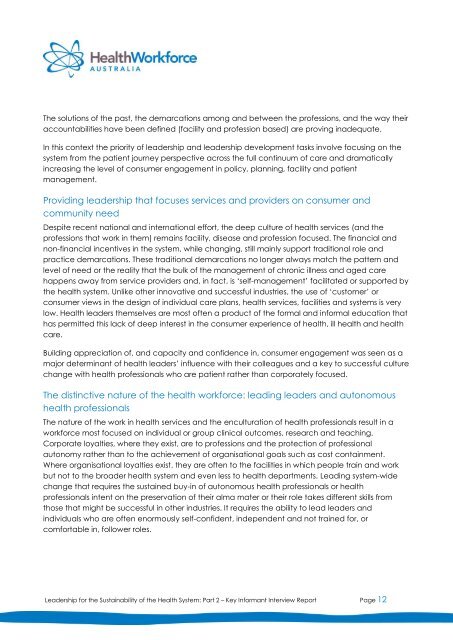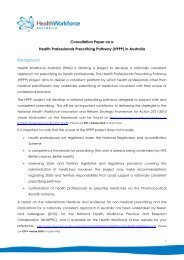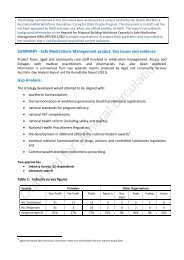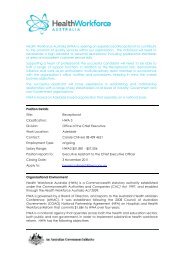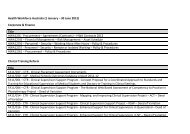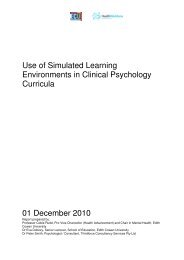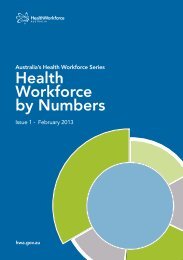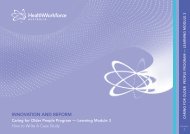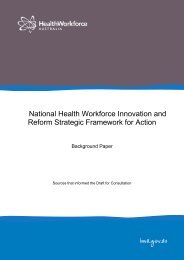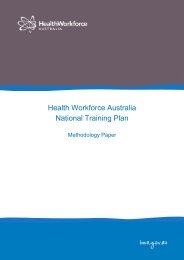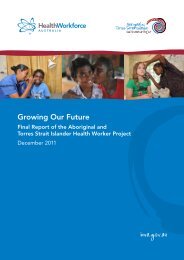Leadership for the Sustainability of the Health System: Part 2 - Key ...
Leadership for the Sustainability of the Health System: Part 2 - Key ...
Leadership for the Sustainability of the Health System: Part 2 - Key ...
You also want an ePaper? Increase the reach of your titles
YUMPU automatically turns print PDFs into web optimized ePapers that Google loves.
The solutions <strong>of</strong> <strong>the</strong> past, <strong>the</strong> demarcations among and between <strong>the</strong> pr<strong>of</strong>essions, and <strong>the</strong> way <strong>the</strong>iraccountabilities have been defined (facility and pr<strong>of</strong>ession based) are proving inadequate.In this context <strong>the</strong> priority <strong>of</strong> leadership and leadership development tasks involve focusing on <strong>the</strong>system from <strong>the</strong> patient journey perspective across <strong>the</strong> full continuum <strong>of</strong> care and dramaticallyincreasing <strong>the</strong> level <strong>of</strong> consumer engagement in policy, planning, facility and patientmanagement.Providing leadership that focuses services and providers on consumer andcommunity needDespite recent national and international ef<strong>for</strong>t, <strong>the</strong> deep culture <strong>of</strong> health services (and <strong>the</strong>pr<strong>of</strong>essions that work in <strong>the</strong>m) remains facility, disease and pr<strong>of</strong>ession focused. The financial andnon-financial incentives in <strong>the</strong> system, while changing, still mainly support traditional role andpractice demarcations. These traditional demarcations no longer always match <strong>the</strong> pattern andlevel <strong>of</strong> need or <strong>the</strong> reality that <strong>the</strong> bulk <strong>of</strong> <strong>the</strong> management <strong>of</strong> chronic illness and aged carehappens away from service providers and, in fact, is ‘self-management’ facilitated or supported by<strong>the</strong> health system. Unlike o<strong>the</strong>r innovative and successful industries, <strong>the</strong> use <strong>of</strong> ‘customer’ orconsumer views in <strong>the</strong> design <strong>of</strong> individual care plans, health services, facilities and systems is verylow. <strong>Health</strong> leaders <strong>the</strong>mselves are most <strong>of</strong>ten a product <strong>of</strong> <strong>the</strong> <strong>for</strong>mal and in<strong>for</strong>mal education thathas permitted this lack <strong>of</strong> deep interest in <strong>the</strong> consumer experience <strong>of</strong> health, ill health and healthcare.Building appreciation <strong>of</strong>, and capacity and confidence in, consumer engagement was seen as amajor determinant <strong>of</strong> health leaders’ influence with <strong>the</strong>ir colleagues and a key to successful culturechange with health pr<strong>of</strong>essionals who are patient ra<strong>the</strong>r than corporately focused.The distinctive nature <strong>of</strong> <strong>the</strong> health work<strong>for</strong>ce: leading leaders and autonomoushealth pr<strong>of</strong>essionalsThe nature <strong>of</strong> <strong>the</strong> work in health services and <strong>the</strong> enculturation <strong>of</strong> health pr<strong>of</strong>essionals result in awork<strong>for</strong>ce most focused on individual or group clinical outcomes, research and teaching.Corporate loyalties, where <strong>the</strong>y exist, are to pr<strong>of</strong>essions and <strong>the</strong> protection <strong>of</strong> pr<strong>of</strong>essionalautonomy ra<strong>the</strong>r than to <strong>the</strong> achievement <strong>of</strong> organisational goals such as cost containment.Where organisational loyalties exist, <strong>the</strong>y are <strong>of</strong>ten to <strong>the</strong> facilities in which people train and workbut not to <strong>the</strong> broader health system and even less to health departments. Leading system-widechange that requires <strong>the</strong> sustained buy-in <strong>of</strong> autonomous health pr<strong>of</strong>essionals or healthpr<strong>of</strong>essionals intent on <strong>the</strong> preservation <strong>of</strong> <strong>the</strong>ir alma mater or <strong>the</strong>ir role takes different skills fromthose that might be successful in o<strong>the</strong>r industries. It requires <strong>the</strong> ability to lead leaders andindividuals who are <strong>of</strong>ten enormously self-confident, independent and not trained <strong>for</strong>, orcom<strong>for</strong>table in, follower roles.<strong>Leadership</strong> <strong>for</strong> <strong>the</strong> <strong>Sustainability</strong> <strong>of</strong> <strong>the</strong> <strong>Health</strong> <strong>System</strong>: <strong>Part</strong> 2 – <strong>Key</strong> In<strong>for</strong>mant Interview Report Page 12


